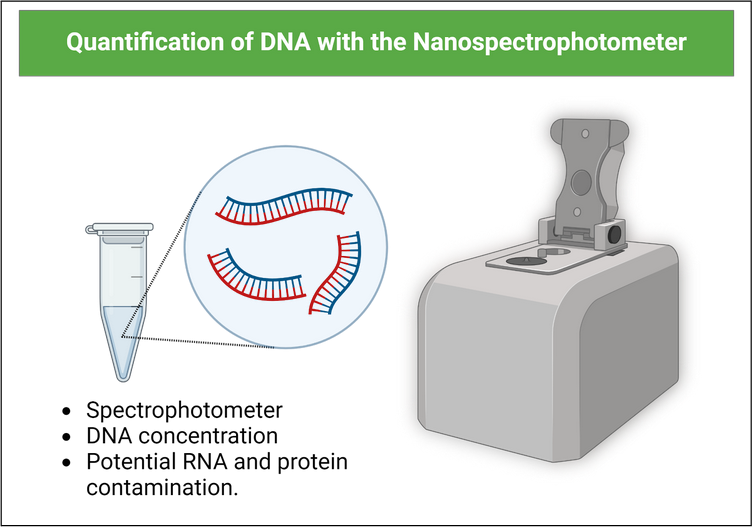45 Activity 1: Quantification of DNA with the Implen Spectrophotometer
Based on the Implen NanoPhotometer® NP80 Protocol.

The Implen spectrophotometer will provide information about the DNA quality and potential contaminants. Created with BioRender.com
1. Turn on the Implen and select “Nucleic Acids”
a. Ensure that the arm is down when you turn on the Implen to ensure that it can properly perform its initialization step.
b. Additionally, check the left sidebar to ensure that the device is set to measure “dsDNA.”
2. Pipet 2 μL of “blank” sample buffer onto the sample window. Lower the arm and click “Blank.”
3. Wipe off the sample window and top sensor with a Kimwipe.
a. The results of the blank should come back near 0 for each metric. If not, clean off the pedestal thoroughly and then load and measure another blank. Once you’ve successfully measured your blank, you may measure your sample.
4. Pipet 2 μL of your sample onto the sample window. Lower the arm and click “Sample.”
5. Record the concentration (given in ng/μL) and the A260/A280 ratio.
6. Wipe off your sample from the sample window and top sensor with a Kimwipe. You may use distilled water sprayed on a Kimwipe and dried with another one to clean the pedestal and mirror.
a. This is crucial to ensuring accurate and consistent results. Two or three wipes on each side is fine, but be sure it is dry each time before moving onto the next sample.
b. Only after cleaning the pedestal can you start to add another sample.
7. Clean the sample window and top sensor by pipetting 2 μL of water onto the sample window, lowering the arm, and gently tapping the arm to make sure that the water contacts the top sensor. Wipe off the pedestal and top sensor with a Kimwipe.
8. Lower the arm to prevent dust from accumulating on the sample window.
Recording you DNA quantifications
1. Create an Excel or Google spreadsheet to keep track of your data from Implen. Title it with the date and the name of your samples. Record the following values:
a. the concentration of your DNA in ng/µl,
b. the ratio of the absorbance at 260 and 280. DNA should have a ratio of 1.8; if RNA is present, the ratio will be higher. If protein is present, the ratio will be lower than 1.8.
c. 230/260 ratio that is used to learn about other substances that may be in your sample.

